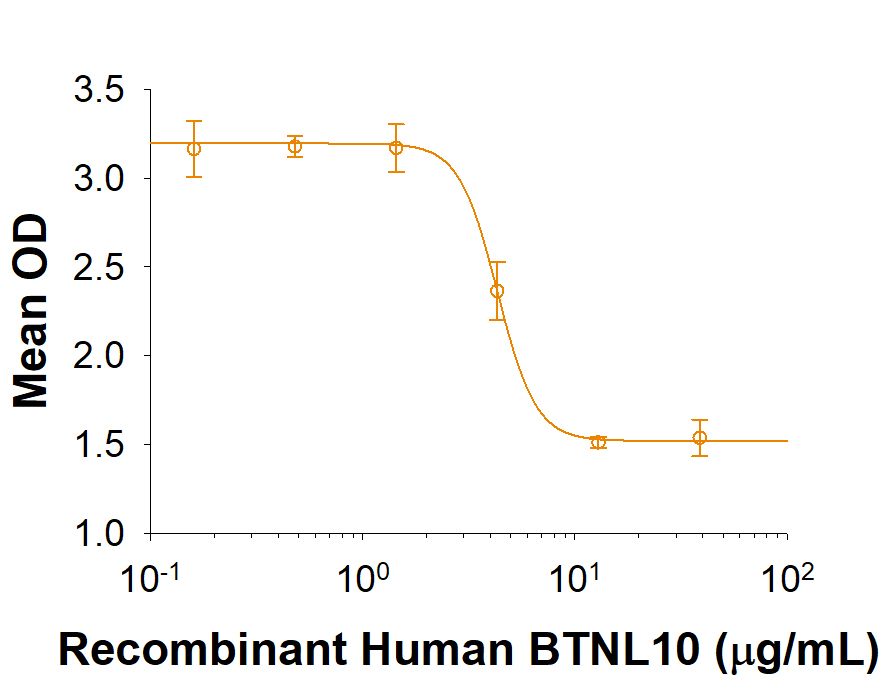Recombinant Human BTNL10/Butyrophilin-like 10 Fc Protein, CF
Recombinant Human BTNL10/Butyrophilin-like 10 Fc Protein, CF Summary
Product Specifications
| Human BTNL10 (Ser27-Gly149) Accession # A8MVZ5 | IEGRMD | Human IgG1 (Pro100-Lys330) |
| N-terminus | C-terminus | |
Analysis
Product Datasheets
Carrier Free
CF stands for Carrier Free (CF). We typically add Bovine Serum Albumin (BSA) as a carrier protein to our recombinant proteins. Adding a carrier protein enhances protein stability, increases shelf-life, and allows the recombinant protein to be stored at a more dilute concentration. The carrier free version does not contain BSA.
In general, we advise purchasing the recombinant protein with BSA for use in cell or tissue culture, or as an ELISA standard. In contrast, the carrier free protein is recommended for applications, in which the presence of BSA could interfere.
10014-BT
| Formulation | Lyophilized from a 0.2 μm filtered solution in PBS. |
| Reconstitution | Reconstitute at 200 μg/mL in PBS. |
| Shipping | The product is shipped at ambient temperature. Upon receipt, store it immediately at the temperature recommended below. |
| Stability & Storage: | Use a manual defrost freezer and avoid repeated freeze-thaw cycles.
|
Scientific Data
 View Larger
View Larger
Recombinant Human BTNL10 Fc Chimera (Catalog # 10014-BT) inhibits IFN-gamma secretion by human peripheral blood mononuclear cells in the presence of anti-CD3 antibody. The ED50 for this effect is 1.5-7.5 μg/mL.
 View Larger
View Larger
2 μg/lane of Recombinant Human BTNL10 was resolved with SDS-PAGE under reducing (R) and non-reducing (NR) conditions and visualized by Coomassie® Blue staining, showing bands at 48-55 kDa and 95-110 kDa, respectively.
Reconstitution Calculator
Background: BTNL10
Butyrophilin-like 10 (BTNL10) is a member of the BTN/MOG Ig-superfamily and functions as a negative regulator of immune cell activation (1). Human BTNL10 is a 291 amino acid (aa) type I transmembrane glycoprotein that contains a signal peptide followed by an extracellular domain (ECD), a transmembrane region, and a short cytoplasmic domain. The ECD of human BTNL10 features a single IgV and a poorly defined IgC domain. The IgV domain of human BTNL10 shares 53% and 52% sequence identity with the equivalent ECD domain of mouse and rat BTNL10, respectively. Although just recently identified, BTNL10 is one of only five butyrophilins conserved between human and mouse (2). While the complete immunological function of BTN/BTNL molecules is only beginning to emerge, they have been shown to be important in immunity by regulating T cell function (2-4). Recent efforts have focused on BTN/BTNL as potential therapeutic targets for a wide range of diseases (2-4). Currently, both the expression pattern and native function of BTNL10 remain unknown. Our data indicate that BTNL10 inhibits the human T cell activation, including IL-2, IFN- gamma secretion, and T cell proliferation.
- Arnett, H.A. et al. (2007) J. Immunol. 178:1523.
- Arnett, H.A. et al. (2012) Immunogenetics. 64:781.
- Abeler-Dörner L. et al. (2012) Trends Immunol. 33(1):34.
- Arnett, H.A. and Viney J.L. (2014) Nat Rev Immunol. 14(8):559.
FAQs
No product specific FAQs exist for this product, however you may
View all Proteins and Enzyme FAQsReviews for Recombinant Human BTNL10/Butyrophilin-like 10 Fc Protein, CF
There are currently no reviews for this product. Be the first to review Recombinant Human BTNL10/Butyrophilin-like 10 Fc Protein, CF and earn rewards!
Have you used Recombinant Human BTNL10/Butyrophilin-like 10 Fc Protein, CF?
Submit a review and receive an Amazon gift card.
$25/€18/£15/$25CAN/¥75 Yuan/¥2500 Yen for a review with an image
$10/€7/£6/$10 CAD/¥70 Yuan/¥1110 Yen for a review without an image
